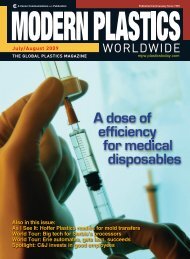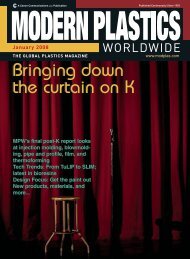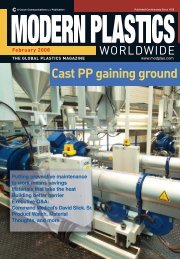amidiq - dae uptlax
amidiq - dae uptlax
amidiq - dae uptlax
You also want an ePaper? Increase the reach of your titles
YUMPU automatically turns print PDFs into web optimized ePapers that Google loves.
260<br />
J. Manuel Loeza-Corte et al. / Revista Mexicana de Ingeniería Química Vol. 6, No. 3 (2007) 259-265<br />
seeking for new technological alternatives that<br />
include the non-destructive exploitation of this<br />
resource in hope that it will provide the inhabitants<br />
of these regions with economical benefits, thus<br />
avoiding its deforestation (Vernon-Carter et al.,<br />
2000). One of the most important aspects of P.<br />
laevigata, which provides it with an added value, is<br />
that it produces a gum that has similar chemical<br />
composition (Orozco-Villafuerte et al., 2003) and<br />
physicochemical properties as those exhibited by<br />
gum Arabic. In general terms, it may be stated that<br />
mesquite gum is the neutral salt of a complex acidic<br />
branched polysaccharide formed by a core of β-Dgalactose<br />
residues (43.3 %), comprising a (1-3)linked<br />
backbone with (1-6)-linked branches (Vernon-<br />
Carter et al., 2000), bearing L-arabinose (40.4 %), Lrhamnose<br />
(1.3 %), β-D-glucuronate (16.2 %)<br />
(Anderson and Weiping, 1989; Vernon-Carter et al.,<br />
2000; Orozco-Villafuerte et al., 2003), and 4-Omethyl-β-D-glucuronate<br />
(Anderson and Weiping,<br />
1989; Vernon-Carter et al., 2000) as single sugar or<br />
oligosaccharide side chains. Mesquite gum also<br />
contains a small amount of protein (0.7-5.8 %),<br />
which may be central to the overall primary structure<br />
branches (Vernon-Carter et al., 2000).<br />
Purified L-arabinose has potential and current<br />
industrial applications. The sweet taste of Larabinose<br />
is similar to that of sucrose, but<br />
approximately half the sweetness. Naturally<br />
occurring arabinose is the L-form, and it is not<br />
metabolized in animals; thus it is a non-caloric sugar.<br />
Furthermore, it strongly inhibits uncompetitively<br />
intestinal sucrase and consequently inhibits the<br />
absorption of sucrose from the small intestine. The<br />
addition of 2-3% L-arabinose to sucrose causes about<br />
a 60 % reduction of the digestion of sucrose in the<br />
small intestine (Susumu, 1999). L-arabinose is<br />
widely used in the development of antiviral agents<br />
such as nucleoside analogues, and is a raw material<br />
in the manufacture of L-ribose, which is used in for<br />
pharmaceutical applications such as synthetic<br />
oligonucleotides (Danisco, 2007). Simultaneous coutilization<br />
of L-arabinose and D-xylose with<br />
recombinant strains of S. cerevisae improved<br />
bioethanol production from lignocellulosic biomass<br />
(Karhumaa et al., 2006).<br />
L-arabinose has been obtained by mild acid<br />
hydrolysis of mesquite gum with 75.0 % (White,<br />
1947) and 40.4 % yields (Orozco-Villafuerte et al.,<br />
2003) based on the maximum theoretical yield<br />
obtainable, estimated from the approximate chemical<br />
composition of the gum used in the experiments.<br />
α-L-Arabinofuranosidase and other arabinases<br />
have been used to produce L-arabinose through<br />
enzymatic hydrolysis of complex polysaccharides.<br />
Apple juice ultrafiltration retentate arabinan was<br />
hydrolyzed by a commercial preparation of Pectinase<br />
29 with a yield of 70.0 % (Rombouts et al., 1988).<br />
Deproteinated sugar beet pulp was hydrolyzed with a<br />
blend of commercial pure α-L-arabinofuranosidase<br />
and endo-arabinase obtaining yields as high as 88.8<br />
% (Spagnuolo et al., 1999). Arabinoxylan from corn<br />
fiber was hydrolyzed with a commercial preparation<br />
of β-xylanase, β-xylosidase and α-Larabinofuranosidase<br />
with 75.8 % yield (Park et al.,<br />
2001).<br />
Enzymatic hydrolysis, as compared to acid<br />
hydrolysis, has the advantages of high specificity on<br />
the substrate, requires mild reaction conditions, and<br />
suffers no loss of saccharide due to side reactions.<br />
After the hydrolysis of complex polysaccharide, the<br />
resultant sugar mixture can be separated by<br />
chromatography (Park et al., 2001).<br />
Thus, complex polysaccharide substrates like<br />
mesquite gum could be used to induce α-Larabinofuranosidase<br />
activity to prepare hydrolysates<br />
such as L-arabinose. Therefore, the aim of this work<br />
was to obtain an enzymatic crude extract with α-Larabinofuranosidase<br />
activity to release L-arabinose<br />
from mesquite gum, and compare these results with<br />
those obtained with a commercial enzyme.<br />
2. Materials and methods.<br />
2.1. Materials<br />
Tear drops were collected from mesquite trees<br />
(Prosopis laevigata) located around the locality of<br />
Río Verde in the Mexican State of San Luis Potosi,<br />
during october 1999 – may 2000. The gum was<br />
purified by dispersing it in water, filtered through<br />
Whatman No. 1 filter paper, dialyzed in double<br />
distilled and deionized water using a cellulose<br />
membrane of 10,000 Da, with water rechanges every<br />
4 h, during 24 h, and dried in a LABCONCO ®<br />
LYPHLOCK 6 (Cole Parmer, Chicago, ILL) freezedrier<br />
(Orozco-Villafuerte et al., 2003). A commercial<br />
α-L-arabinofuranosidase (EC 3.2.1.55) from<br />
Aspergillus niger was purchased from Megazyme<br />
International Ireland Ltd. (Bray Co., Wicklow,<br />
Ireland) with a 99.989 % of purity. Prior to usage the<br />
commercial enzyme was dialyzed in double distilled<br />
and deionized water using a cellulose membrane of<br />
10,000 Da, with water rechanges every 4 h, during<br />
24 h to eliminate the ammonium sulfate and sodium<br />
azide contained in the commercial preparation.<br />
Manufacturer reports 40°C as the optimum<br />
temperature for activity with this enzyme. Potato<br />
dextrose agar (PDA) was obtained from BD DIXON<br />
(BD Company, Sparks, MD). The chemicals NaNO3,<br />
KH2PO4, KCl, MgSO4⋅7H2O, NaOH and Na2CO3<br />
were supplied by J.T. Baker (Xalostoc, State of<br />
Mexico, Mexico). Tween 80, p-nitrophenyl-α-Larabinofuranoside,<br />
p-nitrophenol and L-arabinose<br />
were purchased from Sigma (St. Luis, MO).<br />
2.2. Crude enzymatic extract<br />
A crude α-L-arabinofuranosidase extract was<br />
obtained by filtration of the fermentation broth from









